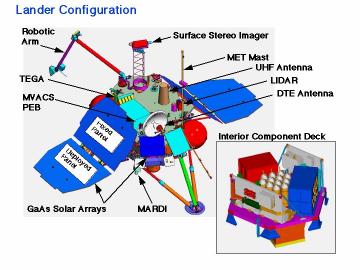
| Mars Volatiles and Climate Surveyor (MVACS) |
|---|

MVACS is an integrated payload with four major science elements:
a Stereo Surface Imager, a Robotic Arm with Camera, a Meteorological
package of pressure, temperature, wind, and water vapor sensors,
and a Thermal and Evolved Gas Analyzer. Dr. David Paige (UCLA)
is the Principal Investigator for the MVACS.
Stereo Surface Imager (SSI)
|
Robotic Arm (RA) & Robotic Arm Camera (RAC)
|
Meteorological Package (MET)
|
Thermal and Evolved Gas Analyzer (TEGA)
|
Stereo Surface Imager (SSI): The mast-mounted SSI provides
panoramas of the Lander site, characterizes the general environment
at the landing site, and provides imaging support for other payload
elements, especially operations of the RA and TEGA, and for the
spacecraft, as needed. The SSI is essentially a clone of the
Mars Pathfinder IMP; it is a multi-spectral imager accessing several
wavelengths between 0.4 and 1.1 microns. This multi-spectral
capability, together with onboard calibration targets, provides
true color images. SSI also images magnetic targets on the Lander
deck to characterize the magnetic properties of surface material.
Narrow-band imaging of the sun provides line-of-sight optical
depths of atmospheric aerosols and (slant column) water vapor
abundances. Stereo imaging is provided by the dual optical lens
systems focusing onto a single CCD.
Robotic Arm (RA); Robotic Arm Camera (RAC):
A two-meter RA with an articulated end member is used to dig trenches
at the site, to acquire samples of surface and subsurface materials,
and to support operations of an attached RA Camera. The RAC will
image the surface and subsurface at close range to reveal fine-scale
layering if present and to characterize the fine-scale texture
of the samples and trench sides. The light-weight RA also supports
a probe for measuring surface and subsurface temperatures.
Meteorological Package (MET): Mounted on a 1.2-m mast,
the MET package includes a wind (speed and direction) sensor,
several temperature sensors, and Tunable Diode Lasers (TDL) which
measure water vapor amounts and specific isotopes of water and
carbon dioxide. A secondary mast (0.9 m in length) is attached
to the main MET mast, and supports a wind speed and two temperature
sensors near the surface saltation layer. Pressure sensors are
mounted within the spacecraft. Once on the surface the MET sensors
are read at periodic intervals, as power permits.
Thermal and Evolved Gas Analyzer (TEGA): TEGA uses differential scanning calorimetry (DSC) combined with gas-specific sensors to determine the concentrations of ices, adsorbed volatiles and volatile-bearing minerals in surface and subsurface samples acquired and imaged by the Robotic Arm (RA). The RA deposits the sample on a grated screen over a chute which fills the sample receptacle. This receptacle is then mated with a cover to form the oven in which the sample is heated; a paired (empty) oven provides a calibration for the heating run. Evolved gases are wafted to sensors which quantify the rate of discharge of oxygen, carbon dioxide and water vapor. Once used, the ovens cannot be used again. TEGA is designed to receive eight surface (soil) samples during the Lander mission.
| Home | Mars Polar Lander | Deep Space 2 Microprobes | Mars Climate Orbiter |
| Welcome | Mailing List | Links | Credits |
For questions or comments on this website please refer to our list of contacts.